|
SHADOW MEETS MIRROR Art as a history keeper, as a time immobiliser, could be the field where the shadow of the subconscious mirrors itself as consciousness 1. Looking at Art from the Artperceptor's view 2. Looking at Art from the Artmaker's view 3. General reflections from the Artperceptor's view 4. Conclusions from both views 1. INTRODUCTION Looking at Art from the Artperceptor's view Perception of Art, general - When art is percepted we deal with two notions: first that something has been made and second that someone looks at it. The onlooker can be the artmaker her/himself or a third, and many ones. Intelligence and Perception of Art - Intelligence appeared there where men started to contemplate in group, in a ritual way, specific forms in nature. Art appeared there where men started to reflect critically, in a ritual way, on images and objects made by themselves. What is Art doing, in general? - Art stands still. She creates socio-energetic necessary end points and fresh perceptual benchmarks. Her cores are to create other meanings in matter, to alter perception by collective contemplation, to induce reflection, deepening, re-opening. Why do we want Art? - The love for art, for the immobile, has to do with the absence of permanent harmony and disharmony. Every living system is in constant motion, it breaks down, builds up, multiplies itself, dies and regenerates. The movements that procure these changes can be of positive or negative charge, but independently they are neutral. Or they occur, or they don't. Best is to consider their occurence as self-evident, unavoidable and necessary. The grief, fear, happiness and fulfillment they are accompanied by can best be considered as the ground principles of each mechanism in evolution. These mechanisms are in the first place human beings, living organisms, but can also be communities, eco-systems and star systems. 2. Looking at Art from the Artmaker's view Shadow meets Mirror: why this title? - Together with a group of artists and scientists I have been involved for 3 years in an art and science project called Parallellepipeda. I worked on the same moment closely in two departments in the University of Leuven, the first was experimental psychology, the second nuclear medicine. These intense years resulted in particular in a deeper insight in the phenomena of retinal after-images and spontaneous brain-imaging. When in the beginning of last year I expressed in a lecture the collapse made in my artistic brain by the combination of this fighting information, I reduced the impact in attributing the effect of mirroring to the psycho-esthetical branche (after-image, history, reflection, confusion, duality, mirror) and the idea of the shadow to the brain-imaging interest of nuclear medicine (spontaneous brain imaging, repetition, novelty seeking, subconscious memory, shadow). This statement made sense, but only for a while. Because I have the impression that the two phenomena cling together when we speak about art. Art as a history keeper, as a time immobiliser, could be the field where the shadow of the subconscious, as the shadow of the information we contain without knowing, mirrors itself as consciousness. Can this computer animation become my theoretical tract? - While I was focusing on the shadow meets mirror issue, I had also been thinking the last year of using a scrap of reality I filmed 10 years ago in Indonesia while giving a workshop there. Somehow it became finally actual to use the footage, but I lacked a good reason. - So 10 years ago I attended with friends a gigantic human gathering in Jakarta, more than 500 000 people where there to hear some speeches of a sacred politician in a time of social disruption. I was struck by a man who succeeded to meditate in the middle of the noise and constant stir around him. It was a beautiful and absurd sight. There was a symbolistic meaning in this that I wanted to use sometime. When this summer, the artist organisation Ruangrupa, who invited me in 2001, asked me to participate in their 10th anniversary-event with a new work, I immediately thought about the man in the crowd. The making of this artpiece could give birth to the words I needed to do this lecture. Film: The Jakarta Two Times My basic footage was that I filmed 1 person meditating in peace in the middle of 500 000 people, in a religious-political gathering, 6 am Jakarta 2001, 32 °C. My procedure was to express the distinctions one-versus-many, sitting-versus- moving, peace-versus-agitation, primal-state-of-nothingness-versus- complicated-state-of-behaving-in-a-mass-gathering. My practical method: 1. I doubled the original film and put it twice in a timeline, in a row. I wanted to create a back and forth. 2. I transformed the images with colors and filters, to express my motivation and to enhance a certain athmosphere of joy and connection. - In the first copy just colors were added. - In the second copy I altered the colors first, than I solarized the whole. (solarization = the effect in physics where the properties of materials are affected by electromagnetic radiation. By overexposure, the light turns into black and after a while at third image can appear, in which contours of different colours and size can emerge) 3. I doubled these again and put them on a second timeline. 4. I made two cross dissolves, one from the first timeline to the second, and one from the second to the first. (In this way the movie will suggest a rhythm and give an agreable feeling of repetition.) 5. The original sound of the gathering is completed with repetitional electronic beats to underline the nervousness of the crowd waiting for the event to begin. 3. General reflections from the Artperceptor's view - The original word for a mirror is speculum. In origin to speculate was to observe the sky and the relative movements of the stars, by means of a mirror. To look at the whole constellation of the stars is then the root of the word "consideration". These two abstract words, defining now high intellectual operations, come from the study of stars reflected in a mirror. This is why the mirror as being a reflecting surface, became the support of an extremely rich symbolism in the order of knowledge. On a universal level, human culture says that a mirror reflects truth, honesty, the content of the heart and of conscience. The mirror is a symbol of wisdom and knowledge, the symbol of the manifestation that reflects creative intelligence. But the mirror gives an inversed image of reality, it stimulates an indirect knowledge. (Dictionnaire des symboles, Jean Chevalier & Alain Gheerbrant, 1969) - Mirror versus reality "Something comes into cognition, and consciousness attempts to structure it. This structure is then taken for the bedrock of reality, and applied as a mappa mundi—first as language, then as ideology inherent in language. These language/ideology complexes tend to become orthodoxies." (Hakim Bey, The Obelisk. 1997) - The mirror as a symbol is lunar and feminine, in China it is the sign for harmony. The Taoists look at the magic mirror in another way: as it reflects the real nature of malevolent influences, it distances them, and protects us against them. The use of the magic mirror corresponds to the oldest forms of divination. Obviously its origin lies in Persia. Pythagoras used it to capture the face of the moon in order to look in the future. The theme of the soul being considered as a mirror, elaborated by Plato and Plotinus, leads to the idea that the mirror's function is not only that of reflecting an image. The soul becoming a perfect mirror, it interferes with the image. A participation that leads to a transformation. Thus there exists a configuration between the contemplated subject and the mirror that contemplates it. The soul finishes by participating in the sole beauty towards which it opens itself. - In opposite of this, the terror of the mirror that inspires self knowledge, the mirror as an instrument of Psyché, has been focused on by psycho-analysis which focused itself on the shady side of the soul. The neo-platonic notion of the two faces of the soul, the inferior side turned towards the body, and a superior side turned towards intelligence executed a big influence on the Sufi's. The musulman mystics say that the body is in the obscurity of the back of the mirror; the soul is the bright side of the mirror. (Dictionnaire des symboles, Jean Chevalier & Alain Gheerbrant, 1969) - So there is a front and a back of a mirror. Let us look at it as an object that captures an image, implicating there is an observer and a light source,.The space behind the mirror must be dark then, and according to the relative distances between observer, mirror and surface/void behind the mirror it has a certain size or is inexistent. Also: when an object is lit by a light source an observer notes that the absence of light created by the obstruction of the light source reflects itself on a surface and becomes a shadow. The relative distance between the object, the light source and the reflecting surface defines the size of the shadow. When the reflecting surface is a mirror the shadow vanishes and transforms into an inverse image of the object, together with the reflection of the observer himself. It is the mirror itself that creates a shadow then, of no importance. - The object doubles itself in two different ways: it reflects itself as a form created as an abscence of light, and it doubles itself as a reflection on a mirroring surface. - The shadow, on the one hand is what is opposite to light. On the other hand, it is the image itself of fugitive, irrealistic and changing things. It has no life, no law of its own. (Dictionnaire des symboles, Jean Chevalier & Alain Gheerbrant, 1969) 4. conclusion Conclusions from both views What happens in the brain of the contemporary art-maker? - The classical way of concept, of using knowledge for investigating, is determined reflection on the shadow of an object of investigation. This shadow is casted on a surface created of what is known before. - The creative act handles the object in its own past (mirroring) and adds the personality of the observer to the image created. The chaos of impressions can turn into something constructive when in real time, in the real world, by means of a materialistic transforming event, perception becomes re-focusing. What happens in the brain of the contemporary art-perceptor? - Images and concepts both exist on a high level of consciousness. Together we experience them as an entire of perception, as an entire of knowledge representation. While looking and/or "understanding" them, the details are of no importance because the image and the concept together work synthetical, as a synthesis of preceding thinking and doing, with an added value of which we get a thrill. - It is on this high level that image and concept can interpenetrate each other. It is possible that the result of such an occurrence leads to a higher or just further level of understanding. In any case it uplifts the human being who takes the effort to look more careful. Because this is what this "contemplation" can induce: to set to work the spirit, to think autonomously, to fulfill the acts of life in a truly creative and inspired way. - Contemporary consciousness is made of perception and the mirrored version of it, the aftereffect of it on what has already been perceived. The context is the mirror, the meaning is the mirrored shadow of content in the mirror, where than the observer sees her/himself in a different fresh way. AMVK.11.2010 (Lecture at The Artist's Institute in New York, 15 May 2011) |
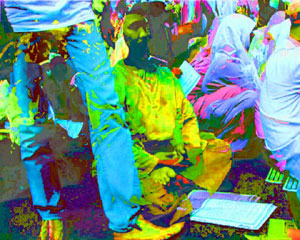 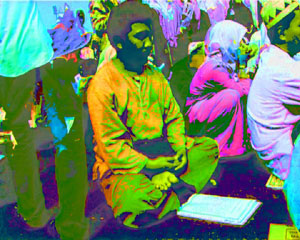 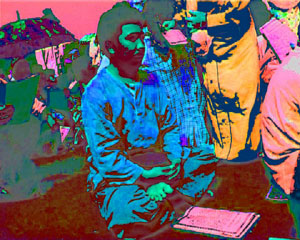 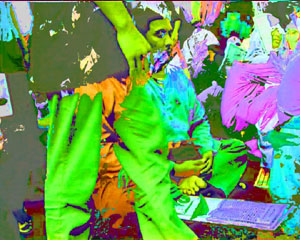 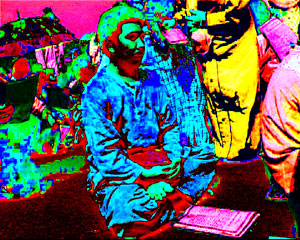 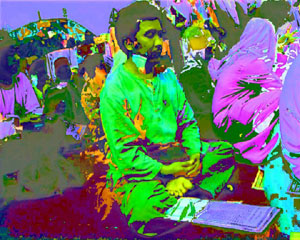 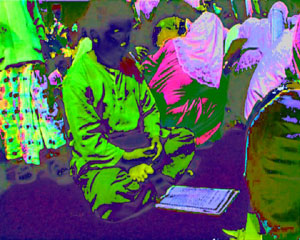 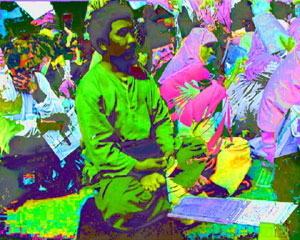 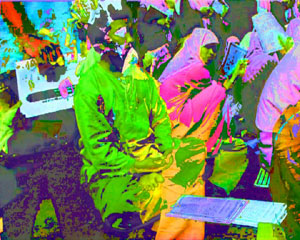 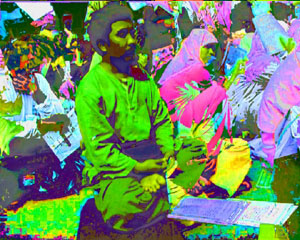 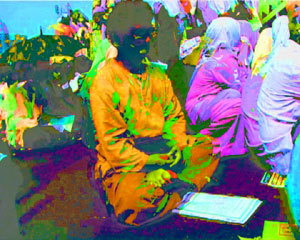 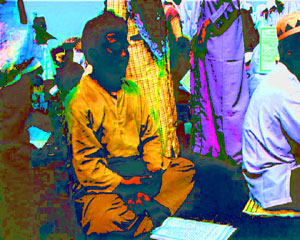     
|
other amvk projects